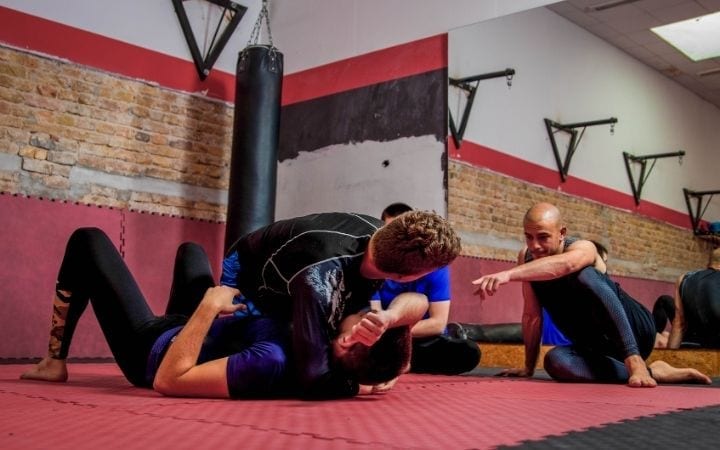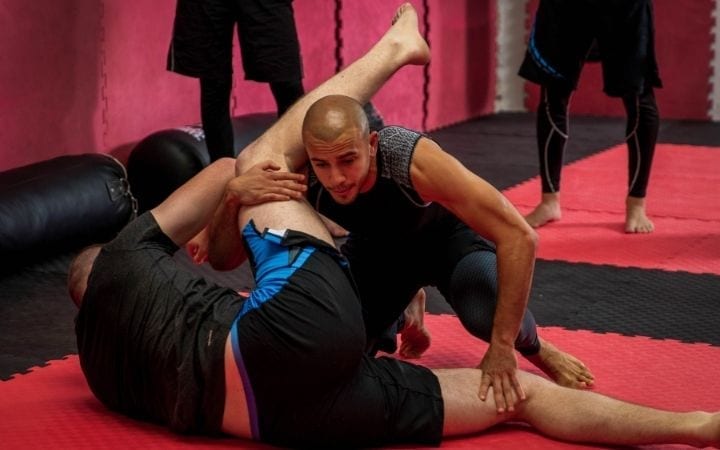All sports have their share of heated topics that their most passionate crowds love to debate. Jiu Jitsu is no exception and has its own perennial debates: sport Jiu Jitsu versus self-defense Jiu Jitsu, American Jiu Jitsu versus Brazilian Jiu Jitsu, and submission-only versus points competition.
However, perhaps the most pervasive Jiu Jitsu argument is training in the gi versus training no-gi. A centered approach to this argument will point out that each training method has its benefits and drawbacks. But, we’re going to examine how training with a no-gi focus can strengthen your Jiu Jitsu game overall.
The Two Training Modalities Of Brazilian Jiu Jitsu
Defining training for gi and no-gi is fairly self-explanatory. However, the dynamics that come with rolling and training in each method have to be experienced to be understood. Generally, many beginners will start Jiu Jitsu training in the gi, as the gi is typically thought to be more traditional to the martial art.
A Jiu Jitsu gym will likely have a class schedule that dedicates specific times and days to gi and no-gi sessions separately, given the different methods for training each. Although many gyms have a balance of class types, you can often tell if your gym skews more gi or no-gi on open mat days where you can plainly see which method is more heavily represented.

Depending on which method is trained more at your gym, you may be accustomed to hearing constant justifications that purport the superiority of that method. You might hear things like “gi makes you more technical” or “no-gi is more realistic.” Even the terms “technical” or “realistic” are so subjective that they hardly offer the topic any real conclusion.
The dynamic difference in the two training becomes more clear in competition. The popularity of leg attacks has bolstered no-gi popularity as it does not place the same restrictions on the submission system as many gi divisions do.
However, the ebb and flow of popularity of techniques, systems, and celebrities within Jiu Jitsu give a clearer picture of which way the culture is swaying. As athletes like Gordon Ryan continue to dominate the no-gi landscape (and your Instagram feed) and events like ADCC are becoming a mainstream proving ground for nearly every Jiu Jitsu athlete, it seems apparent that no-gi is on the rise.
What Makes No-Gi BJJ Different From Gi Jiu Jitsu
The most obvious difference between gi and no-gi Jiu Jitsu is their respective gripping systems. In no-gi you have natural, anatomical grips such as your opponent’s wrists, ankles, neck, and other limbs.
These grips are available in gi, but practitioners typically forgo them in favor of more traditional and, at times, more advantageous gi grips. While in gi, you have thick lapels, sleeves, and pants to grip onto in order to enact your game.
One intricacy of the difference in gi and no-gi grips is the use of your whole hand versus using your fingers. Typically, in gi training, to grab hold of the gi, you grip with your fingers (save for your thumb in many instances). In no-gi, since the focus is limb grabbing instead of fabric, you are creating a closed loop with your whole hand, which will not stress your fingers as much.
You may notice the tell tale dead forearms after an intense gi session, while no-gi is typically not as taxing on your grips.

Aside from the grips, the repertoire of techniques changes from gi to no-gi. It might be tempting to think that gi provides you with more technical opportunities. But, creativity will likely give you enough leeway to approximate most gi techniques in a no-gi setting.
Because there is no gi material to grab onto, attacks in no-gi tend to be much more direct, since the extra step of manipulating the gi to then manipulate the body isn’t necessary. For example, a rear naked choke in no-gi is just a matter of attacking the neck. Whereas, a rear collar choke entails first moving the gi lapels in position to then be able to apply a strangle.
While this does not inherently make no-gi superior to gi, it might explain why you sometimes find yourself using no-gi grips even when training gi. Lastly, the way in which gi and no-gi practitioners engage in standup exchanges differ greatly.
In no-gi, there is a greater emphasis on wrestling as the standup style of choice. While wrestling is possible in the gi, many shot attempts can be stopped with a strong lapel or sleeve grip. In a gi, Judo is a common choice for standup exchanges.
And while sitting or pulling guard is not exclusive to gi practitioners, the wider range of open/lapel guard options that the gi provides may make it a more appealing option. Someone sitting guard in no-gi is perhaps more interested in the range of leg attacks the no-gi ruleset allows.
How No-Gi BJJ Can Make You Better With The Gi
One major aspect that is beneficial to no-gi overall is beginning to understand your effect on another’s anatomy. We’ve touched on the ideas of natural grips and the extra step of manipulating the gi to manipulate the body, so try to implement those ideas into your game.
At times, in gi training, when a particular gi grip is not working you may feel you’ve reached the extent of your Jiu Jitsu knowledge. But, remember, the gi is not whole of Jiu Jitsu. If you’re gi grips are not working, default to the natural grips your opponent’s body presents.
In this way, your no-gi training does not have to replace your gi knowledge, but rather, it acts to complement it and fill in any gaps. Similarly, if much of your no-gi standup is wrestling based, or at the very least is not reliant on gi grips, try to incorporate that into your gi training.
If you do not have the finesse or know-how to implement gi grips for proper Judo, use wrestling and natural grips to takedown your opponent.

Lastly, anyone who’s trained both methods can probably attest the liberating feeling you get from shedding your gi after a few intense rolls. No-gi offers you a sense of greater agility and speed.
Whether or not that sense of speed is psychological, use the mental and physical boost to work on smoother, faster transitions unencumbered by someone yanking you down by your clothes. Fold this greater movement speed and smoothness back into your gi game.
Training Gi versus a No-Gi Opponent
For an added training challenge, try training in your gi against someone training no-gi. Observe their technical priorities and compare them to yours. Although it may seem unbalanced, allow them to use your gi against you.
This will add a layer of problem solving to your Jiu Jitsu game as your opponent has such a clear advantage over your from the start. Many times when two practitioners are rolling against each other in the gi there is the temptation to combat their grips with grips of your own. While this can work in many cases, this “fire versus fire” mentality will distract you from actually breaking their grips in the first place.
If your opponent is training no-gi against your gi, you will have no other option but to address and break their grips before you can proceed.
Summary
While many debate the superiority of gi versus no-gi, it is important to remember that each has its own set of benefits and drawbacks.
There is a change in mentality when you train in no-gi, and it is important that you learn to confront and embrace that change. Applying principles from your no-gi game to your gi game will make your Jiu Jitsu better overall.
Jeremy is brown belt and has a Bachelor’s degree in journalism, but he also enjoys creative writing. Originally from Connecticut, where he began his 11 years of Jiu Jitsu training.
